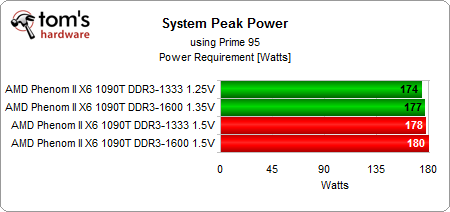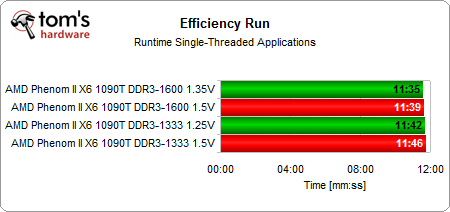How Much Power Does Low-Voltage DDR3 Memory Really Save?
Kingston’s HyperX LoVo-series DDR3 memory allows users to reduce voltage to 1.35 V or 1.25 V in order to save power and allegedly decrease system temperature. We test the eco-friendly modules to find out if it really makes sense to run undervolted memory.
Benchmark Results: System Power Consumption And Single-Thread Efficiency
System Power Consumption
System idle power decreases, but only by 1 W at most. This isn't enough to justify paying more for a low-power memory product, even on systems targeting under 30 W of total idle power.
The decrease in peak power is more significant, though. A 4 W to 6 W decrease is quite a bit, given that the only real modification is a reduction in memory voltage.
Single Thread Efficiency
Let’s look at the impact of these slightly decreased power consumption numbers on performance in single-threaded applications.
A few seconds of difference in our workload don’t justify additional expenses, but Kingston's LoVo memory does provide a marginal advantage.
Average power consumption during our efficiency run on a single-threaded application decreased by 1 W to 2 W, depending on the memory speed.
Get Tom's Hardware's best news and in-depth reviews, straight to your inbox.
The total power used to complete this workload decreased as well, mostly because of having almost identical performance at decreased power. The end result isn't much, but it's worth considering if you want to optimize for low power.
Current page: Benchmark Results: System Power Consumption And Single-Thread Efficiency
Prev Page Benchmark Results: Audio/Video Next Page Benchmark Results: Multi-Thread And Overall Efficiency



